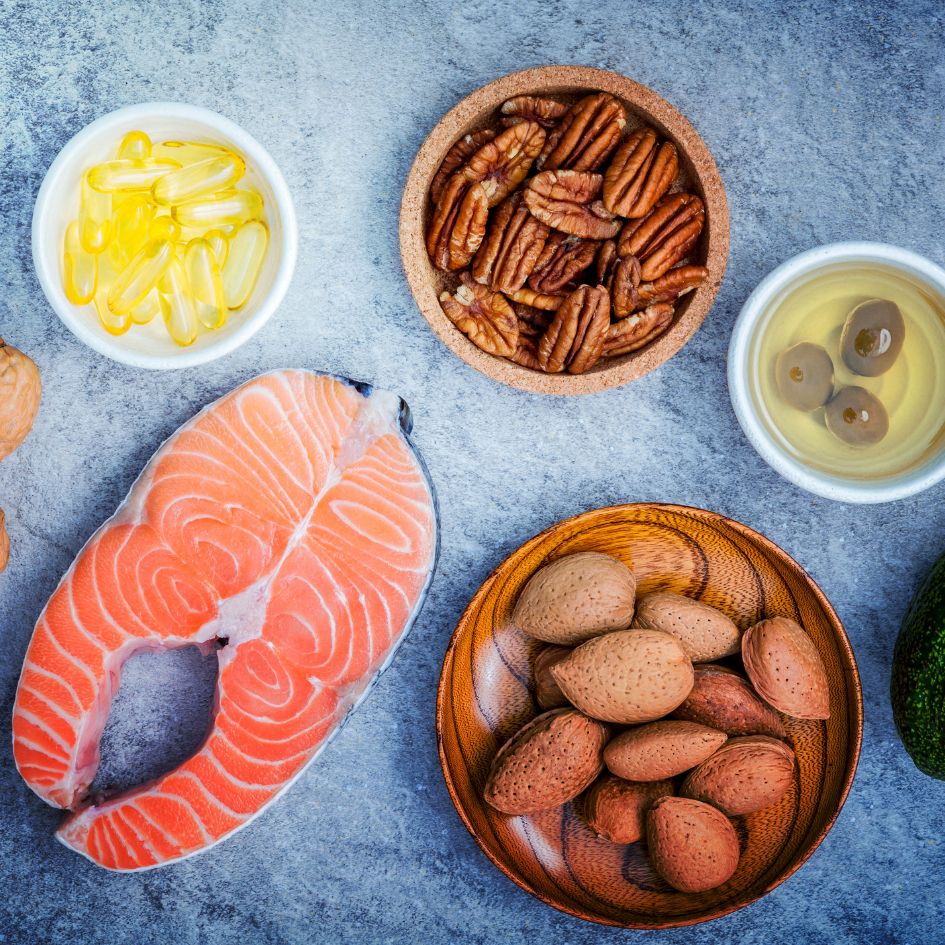
Nutrition for Arthrosis: What to eat when you have joint pain?
Osteoarthritis is usually caused by an inflammatory process. Patients with painful joint problems or osteoarthritis should try to minimize inflammation in the body. With the "right" diet, this inflammation in the painful joints can be significantly reduced! It is not necessary to resort to anti-inflammatory drugs, which put a strain on the liver and kidneys if taken for a long time. A change in diet can have a big impact and in some cases make taking tablets or applying painkillers unnecessary . But what should you pay attention to when it comes to diet for osteoarthritis ? We have compiled a list of foods that help with joint pain and which ones you should avoid in this article.

Preventing osteoarthritis through diet
The daily menu for people with osteoarthritis or joint problems should include plenty of vegetables, salads and healthy vegetable oils to reduce inflammation in the body.
Excessive meat consumption should be avoided . Red meat and sausage in particular contain many substances that promote inflammation. One of them is the omega-6 fatty acid arachidonic acid, which is found in high quantities in pork and sausage. Too much sugar also promotes inflammation . It is therefore advisable to limit the consumption of sweets, cakes, pastries and white flour products. In addition to the substances that promote inflammation, these products also have a high calorie density. This should be taken into account, as being overweight can often be a cause of joint problems and pain. Every kilogram of excess body weight puts additional strain on the joints and promotes joint wear and tear . This places particularly high strain on the hips, spine and knee joints! When walking normally, for example, the knees have to cushion 2.5 times the body weight, and when going down stairs even 3.5 times.

Vitamins, minerals and trace elements for osteoarthritis
Vitamins, minerals and trace elements are necessary for the supply of joint cartilage and are found in numerous types of fruit and vegetables. These include vitamins C, D, E and the B vitamins. The influence of vitamin E on the joints is particularly noteworthy here ; it promotes the growth of cartilage cells (chondrocytes) and reduces the breakdown of cartilage tissue through its anti-inflammatory effect. You should also ensure that the joints are adequately supplied with calcium, magnesium, zinc, selenium and copper.

Secondary plant substances in some fruits and vegetables, herbs and spices have antioxidant and anti-inflammatory properties. Positive effects are shown, for example, by broccoli and horseradish (mustard oils), garlic (allicin), blueberries (anthocyanidin), rose hips (polyphenols, vitamin C) and turmeric (curcumin).

Which fats help with osteoarthritis?
Omega-3 fatty acids have a strong anti-inflammatory effect and are found in high quantities in fatty cold-water fish such as salmon, herring and mackerel. In addition, vegetable oils such as linseed oil, hemp oil or walnut oil contain a very high proportion of omega-3 fatty acids.
Omega-3 fatty acids are long-chain, polyunsaturated fatty acids. They are part of cell membranes in the body and precursors of biologically active substances (eicosanoids). Omega-3 fatty acids include alpha-linolenic acid (ALA), which is an essential fatty acid and cannot be produced by the body. The other two metabolically active omega-3 fatty acids are called eicosapentaenoic acid (EPA) and docosahexaenoic acid (DHA). Our body can produce them itself in small amounts from ALA. The rest of our EPA and DHA requirements must be covered through our diet.
Under the influence of enzymes (cyclooxygenases and lipoxygenases), arachidonic acid and eicosapentaenoic acid are converted into the messenger substances prostaglandins and leukotrienes in different variants. These messenger substances play an important role in pain transmission and in inflammatory processes in the body. Prostaglandins and leukotrienes, which are formed from eicosapentaenoic acids, have anti-inflammatory properties. The prostaglandins and leukotrienes from arachidonic acid, on the other hand, have a pro-inflammatory effect and promote inflammatory reactions .
In a placebo-controlled, randomized and double-blind study over 4 months, a daily dose of 2,500 mg EPA/DHA was able to achieve a significant reduction in chronic inflammation [1] . For healthy people, 300 - 600 mg EPA/DHA per day is recommended.
In order for omega-3 fatty acids to work well in the body, our diet must not contain too many omega-6 fatty acids such as arachidonic acid. Omega-6 fatty acids are found in sunflower or safflower oil, for example, and often in processed foods and pork. Omega-6 and omega-3 fatty acids are processed using the same enzymes and therefore compete with each other. On average, our food contains 10 to 20 times more omega-6 than omega-3 fatty acids. The ratio of omega-6 to omega-3 should actually be between 1:1 and 5:1 .
The influence of fatty acids on the joints
Overweight people suffer from osteoarthritis much more frequently. According to current studies, this is not only due to the high weight load on their joints. A study on rats from 2017 [2] showed that a diet high in sugar and saturated fatty acids can directly damage the joint cartilage and the underlying bone. The researchers fed the animals either corn or various diets high in sugar combined with saturated fats or trans fats. The extent of osteoarthritis depended on how long the fatty acid chains were. The most beneficial diet was one with a high proportion of lauric acid (found in coconut oil, for example), which is relatively short at 12 carbon atoms (C12). The damage was more pronounced in a diet containing myristic acid (C14), palmitic acid (C16) and stearic acid (C18). Stearic acid is an important component of animal fats and palmitic acid from palm oil is often a component of ready meals. Lauric acid increased the release of proteoglycans, which give cartilage its strength.
Since osteoarthritis usually causes problems in the hip and knee joints, the problem has so far been attributed to the excessive strain on the joints as a result of obesity. However, as osteoarthritis progresses, non-load-bearing joints are often also affected in addition to the so-called load-bearing joints.
Another recent study from 2020 evaluated the data from 4 cohort studies with a total of 4,497 participants [3] . The analysis of the serum samples showed that an excessive proportion of fatty acids with long carbon chains in the blood is associated with an increased risk of osteoarthritis .

Is coffee bad for your joints?
Excessive coffee consumption is repeatedly linked to an increased risk of osteoarthritis and arthritic joint problems. So is coffee bad for the joints?
A recent cohort study with data from 333,214 participants in the UK from 2020 examined a link between habitual coffee consumption and the risk of osteoarthritis and other diseases. It was able to demonstrate an increased risk of osteoarthritis for coffee drinkers. People who drank more than 6 cups of coffee a day showed an increased risk of osteoarthritis . Interestingly, an increased risk of osteoarthritis was also shown in people who did not drink coffee [4] . This study also linked a higher risk of gout with excessive coffee consumption . According to another study from 2020 [5], the effect of coffee consumption on the joints is attributed to the caffeine it contains. According to the study, under the influence of caffeine, there is a reduced formation of the extracellular cartilage matrix (ECM). The proliferation and spread of chondrocytes is inhibited by a reduced release of growth factors and an irregular cartilage surface is formed.
SOURCES:
- Kiecolt-Glaser, JK, et al., Omega-3 supplementation lowers inflammation in healthy middle-aged and older adults: A randomized controlled trial. Brain, Behavior, and Immunity, 2012. 26 (6): p. 988-995.
- Sekar, S., et al., Saturated fatty acids induce development of both metabolic syndrome and osteoarthritis in rats. Scientific Reports, 2017. 7 (1): p. 46457.
- Meessen, JMTA, et al., Serum fatty acid chain length associates with prevalent symptomatic end-stage osteoarthritis, independent of BMI. Scientific Reports, 2020. 10 (1): p. 15459.
- Nicolopoulos, K., et al., Association between habitual coffee consumption and multiple disease outcomes: A Mendelian randomization phenome-wide association study in the UK Biobank. Clinical Nutrition, 2020. 39 (11): p. 3467-3476.
- Guillán-Fresco, M., et al., Caffeine, a risk factor for osteoarthritis and longitudinal bone growth inhibition. Journal of Clinical Medicine, 2020. 9 (4): p. 1163.




1 comment
Ich leide unter einer Arthrose und möchte alles tun, damit es mir in Zukunft besser geht. Ich gehe schon regelmäßig zur Therapie und das hilft sehr. Die Ernährung spielt jedoch immer eine wichtige Rolle. Gut zu wissen, dass Omega 3 sehr entzündungshemmend wirkt. Ich esse immer Walnussöl zu meinem Salat, aber dann werde ich die Dosis erhöhen.
https://vitalplus.biz/physio/
Lisa Schmidt
Leave a comment
This site is protected by hCaptcha and the hCaptcha Privacy Policy and Terms of Service apply.